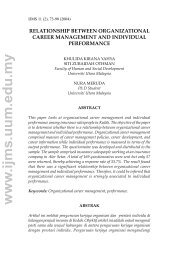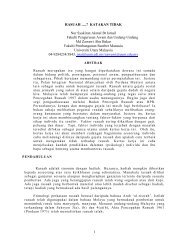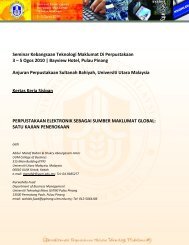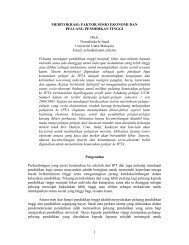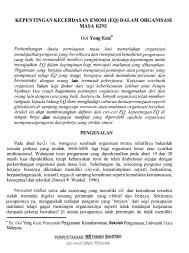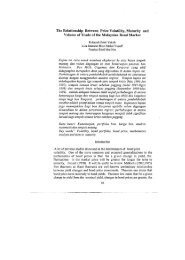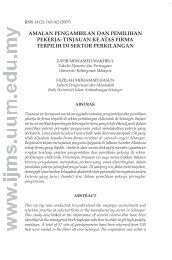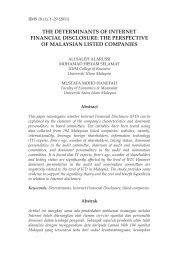The Development of ASEAN from Historical Approach
The Development of ASEAN from Historical Approach
The Development of ASEAN from Historical Approach
Create successful ePaper yourself
Turn your PDF publications into a flip-book with our unique Google optimized e-Paper software.
www.ccsenet.org/ass Asian Social Science Vol. 7, No. 7; July 2011<br />
country. <strong>ASEAN</strong> countries face various political and security challenge. It is <strong>of</strong>ten related to the shift <strong>of</strong> leadership<br />
power, frequently dabbed leadership crisis in several <strong>ASEAN</strong> countries like those occurred in the Philippines and<br />
Indonesia. Almost every <strong>ASEAN</strong> country are compelled to impose certain restrictions to the freedom <strong>of</strong><br />
politicking like those carried out in western countries to ensure internal politics and maintenance <strong>of</strong> peace stability.<br />
3.4 Non Intervention's Policy And Constructive Engagement <strong>ASEAN</strong><br />
Among basic principles <strong>of</strong> <strong>ASEAN</strong> utilized to hold the relationship between country member is the<br />
non-intervention policy in internal affairs <strong>of</strong> respective countries. In fact this principle is the major content in most<br />
important documents <strong>of</strong> <strong>ASEAN</strong> such as <strong>The</strong> Zone <strong>of</strong> Peace, Free and Neutrality Declaration (ZOPFAN) sealed in<br />
year 1971 and Treaty <strong>of</strong> Amity and Cooperation <strong>of</strong> Southeast Asia in year 1976. <strong>The</strong> principles <strong>of</strong> ZOPFAN was<br />
announced by foreign ministers <strong>of</strong> <strong>ASEAN</strong> during the Kuala Lumpur declaration on the 27th <strong>of</strong> November 1971.<br />
ZOPFAN’s main purpose is to create peace and political stability in Southeast Asia and to avoid political and<br />
military intervention <strong>from</strong> superpowers like the United States, China, and Russia in the region. With this<br />
agreement, country members should not be involve in the political arena <strong>of</strong> superpowers. <strong>The</strong> concept <strong>of</strong> its<br />
establishment is hoped to create friendship with every country in the world regardless <strong>of</strong> political ideology so that<br />
peace and security in this region is further guaranteed (Ghazali Shafie,2002:69). It also is hoped to peacefully solve<br />
any dispute in Southeast Asia without exercising force.However, the effectiveness <strong>of</strong> this neutral policy is <strong>of</strong>ten<br />
debated among <strong>ASEAN</strong> members. <strong>The</strong> interest to change this principle was voiced by Thailand and Philippines<br />
which tried to suggest the flexible interaction approach or healthy intervention enabling a small amount <strong>of</strong><br />
intervention without jeopardizing the non-intervention principle. In the effort to use confidence building steps and<br />
preventive diplomacy in the future, it will form a guideline which would enable intervention only in certain<br />
circumstances.<br />
<strong>The</strong>re are signs exhibiting that <strong>ASEAN</strong> has started to move little by little towards limited intervention. For<br />
example in coup d’etat and conflict issue in Cambodia, <strong>ASEAN</strong> decided to become the middlemen to resolve<br />
Cambodia’s problem. That particular move successfully persuaded the conflicting parties to negotiate and this<br />
approach has openly solved the internal crisis in Cambodia which happened in the late 1970s until early 1990s. <strong>The</strong><br />
effectiveness <strong>of</strong> indirect intervention or limited intervention could be related to the increase <strong>of</strong> dependence among<br />
<strong>ASEAN</strong> countries and SEA countires confidence towards the <strong>ASEAN</strong> organization.<br />
3.5 Southeast Asia Nuclear Weapons-free Zone (SEANWFZ)<br />
<strong>ASEAN</strong> has constantly strived to enhance peace stability in this region thus the SEANWFZ agreement known as<br />
Southeast Asia nuclear weapons-free zone was signed by 10 <strong>ASEAN</strong>’s head <strong>of</strong> states in 1995 (Nasrudin<br />
Mohammed:104). <strong>The</strong> SEANWFZ's concept is an agreement to avoid member countries <strong>of</strong> possessing, placing<br />
and utilizing nuclear weapon. This concept merely ensures that nuclear energy would be employed for peaceful<br />
purposes. <strong>ASEAN</strong> countries are prohibited <strong>of</strong> owning, manufacturing, transporting and using nuclear weapon. In<br />
other words, <strong>ASEAN</strong> uses SEANWFZ to rejected any deployment, preservation and possesion <strong>of</strong> nuclear weapon<br />
by any member country. This is <strong>ASEAN</strong>'s principle maintaining peace and avoid nuclear weapon threats in the<br />
Southeast Asia region.<br />
3.6 Confidence Building Measures (CBM)<br />
Diplomacy is a policy based on negotiation between countries or international entities to achieve a specific<br />
objective (Raymond Aron, 1968:5). It is a bilateral interaction in the international arena, methodes and skills to<br />
execute negotiation (Mohd Fo’ad Sakdan, 2003:34). Preventive diplomacy concerns with the efforts in settling<br />
potential conflicts <strong>of</strong> war. This action should be taken to prevent war and the most vital action during this stage is<br />
Confidence Building Measure (CBM) (Paul Wolfowitz, 1994: 4-5). Prevention and solution through diplomacy<br />
will be used if peace in an area or zone crisis is menaced. More <strong>of</strong>ten than not, international community will try to<br />
prevent lingering conflicts diplomatically. According to Gareth Evans (1993:77):<br />
“Diplomatic measures would be employed to reduce and prevent crisis and avoid terrorism" .<br />
When a dispute occurs within a country, external intervention is important to prevent the plagued <strong>of</strong> dispute<br />
through readiness and deterrence. Military intervention may be adopted by stationing military forces in conflicting<br />
countries in order to control the conflict. <strong>The</strong>refore the prevention conflict or war could be achievable by<br />
implementing a few approach guaranteeing the security and peace, for instance the CBM method.What are the<br />
steps in confidence building or Confidence Building Measure (CBM)? CBM is concept that can be viewed <strong>from</strong><br />
various angles. J.J Holst and K.A Melander (1977:147) explained that the concept <strong>of</strong> CBM have been carried out in<br />
Europe since the 1960s. <strong>The</strong>y clarified that:-<br />
174<br />
ISSN 1911-2017 E-ISSN 1911-2025




